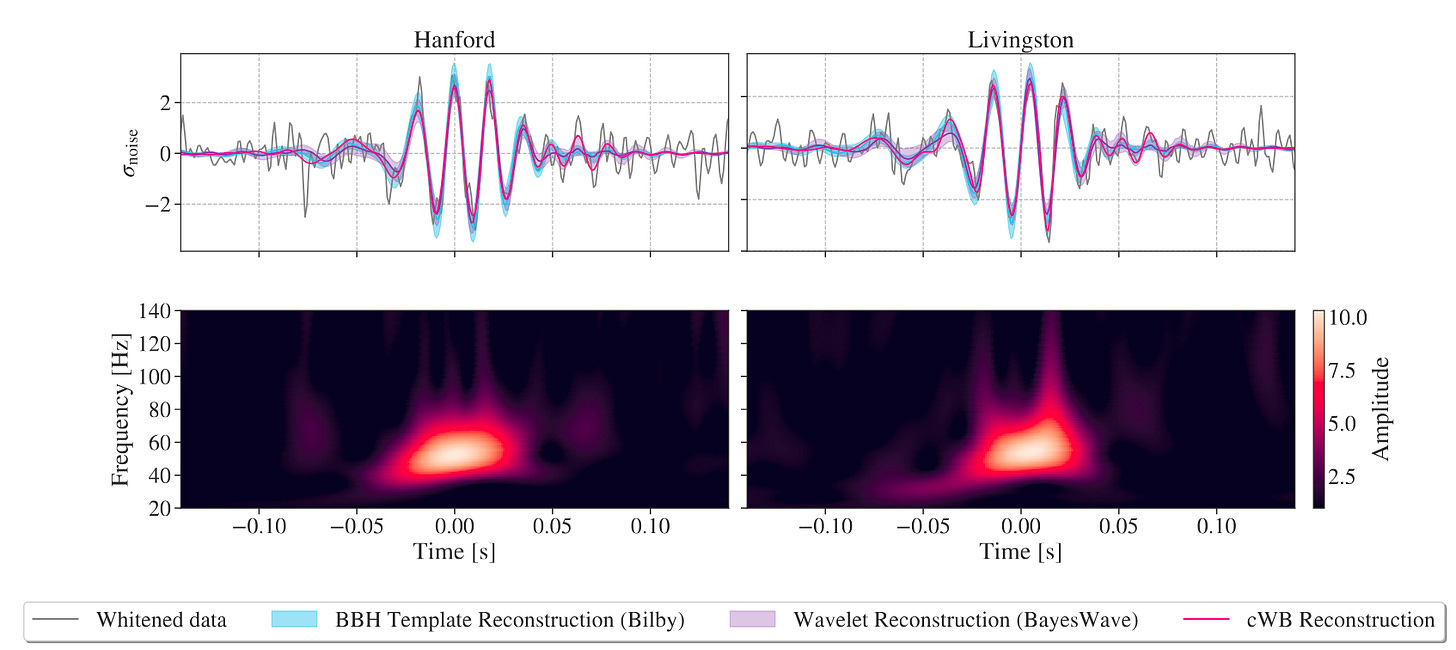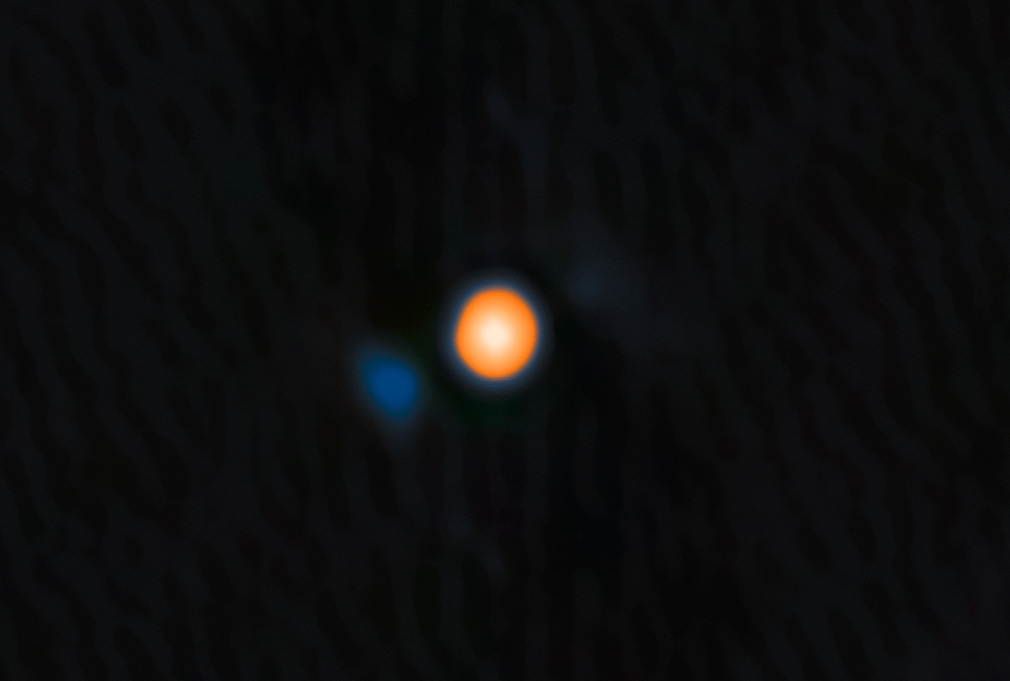The Week in Space and Physics: When Giants Collide
On black hole collisions, hypervelocity stars, Betelgeuse's companion, and a hint of the missing antimatter.
In November 2023, a pair of observatories, one in Louisiana, the other in Washington State, picked up the signal of two massive objects spiralling towards a collision. The fact they could do this at all is astonishing: the signal we are talking about was the signature of a passing gravitational wave, marked by a subtle stretching and contracting of space and time itself. This signal was so slight, indeed, that even Einstein doubted we’d ever be able to detect something like it.
And yet we can. Even more remarkably, we can tell you something about what caused it. The waves of November 2023, researchers have found, were created by a pair of black holes dancing as they fell towards each other. Each weighed over a hundred solar masses, and as they danced, they warped and distorted the space-time around them. The result was a ripple of waves spreading outwards, a ripple that eventually, after billions of years, swept over the Earth.
Our observatories saw this dance as a signal lasting only a tenth of a second. Yet it was picked up by both detectors, and so, despite its brief nature, early analysis identified it as a significant event. Later work revealed just how important it really was: the collision seems to have been the biggest yet seen, creating a black hole with a total mass three hundred times greater than that of the Sun.

But even more surprising were the black holes that took part in the collision. Both, analysis showed, lay in a “forbidden” range of masses, and so their mere existence seems to defy our ideas about how black holes should be born. Mark Hannam, one of the researchers involved in the study, says the problem emerges from our current models of dying stars.
Stars up to sixty solar masses, he notes, can easily collapse into black holes. But when stars get bigger than this, they tend to completely blow up rather than collapse into black holes. At some heavier mass, stars should tend to once again implode and form black holes, but the limits of when this can happen are poorly known.
All this means there should be a gap in black holes masses between around sixty and at least one hundred and thirty solar masses. But for some unknown reason, the black holes studied here seem to break this rule.
There are two possible explanations, Hannam writes. The first is that we really are seeing forbidden black holes. If so, it means either our theories about how big stars collapse are wrong, or the black holes in question are themselves the products of past mergers.
The other possibility, however, is that we have misread the data. In that case, the black holes might be larger or smaller than we think, and so may not be forbidden at all. The problem, Hannam says, is that our best models give different answers when they analyse the available data.
In one possible scenario, both black holes lie in the forbidden zone. In the other, one of them lies above the upper threshold, while the other is below the sixty solar mass limit. For now, we cannot say for sure which is right. But we will keep trying, Hannam says, and seek to reduce the uncertainties.
To be sure, uncertainty is to be expected here. Scientists like Hannam are studying collisions which we have only just learned to detect, and trying to match them with ideas about how the biggest stars in the universe die. None of this is easy to get right. But in time, studies like this should cast light on how some of the most violent events in the universe play out.
Mark Hannam has a newsletter on Substack, and has written a great article on this study. Please do read it, he explains the topic far more clearly than I ever could.
An Intergalactic Shooting Range
Get too close to a supermassive black hole, and you probably aren’t coming back alive. The immense tides exerted by these cosmic beasts can rip a star apart, and, indeed, from time to time we really have seen bursts of energy coming from such tortured stars.
But there is one way to escape: when binary stars draw close to a black hole, one of the two stars can be hurled out at enormous speeds. The other is less lucky. The escape of its companion dooms it, and before long it will be shredded and consumed by the black hole.
Still, the high speed – or hypervelocity – stars resulting from such encounters have occasionally been seen. Most are travelling at an extreme rate, with some traversing more than a million kilometres every hour. They are, invariably, on a trajectory heading out of the galaxy itself, and will one day find themselves crossing the vast distances of intergalactic space.
The Gaia telescope spotted about twenty of these stars near the edges of the Milky Way. Many of these, a recent study found, came from the supermassive black hole at the heart of our galaxy. But a few trace back to the Large Magellanic Cloud, a galaxy that is in orbit around our own.
Though a supermassive black hole has never been observed within the Large Magellanic Cloud, this study seems to suggest there is one. That would make sense – most galaxies, after all, do seem to have a big black hole at their centres. But the study also suggests it is relatively small, weighing in at around six hundred thousand solar masses, or roughly an eighth the size of the one at the heart of the Milky Way.
Does Betelgeuse Have A Companion?
Betelgeuse is one of the most fascinating stars in the night sky. It is fairly close, lying only a few hundred light years from Earth. It is also dying, and will probably explode dramatically sometime in the next few tens of thousands of years. And it seems to vary in strength, sometimes becoming one of the brightest stars in the night sky, at others fading away almost entirely.
In the past, astronomers have speculated that some of this variability might be explained by a small companion star to Betelgeuse. If it exists, models predict it would orbit the bigger star once every six years, and that it might be about the size of the Sun. Betelgeuse, by comparison, is so large that it would engulf all the planets out to Jupiter if only it lay at the centre of our solar system.
Previous observations have hinted at the presence of this companion star. But none have been conclusive. Yet a new study, based on observations from 2020 and 2024, and using a model of the star’s possible orbit around Betelgeuse, claims to have found the strongest evidence yet. They say that in 2020, the star should have been behind Betelgeuse, and indeed, they see no sign of it in measurements taken that year.
But by 2024 the star would have moved out to the side. Observations do show something visible in that year, but whether it is really the predicted companion to Betelgeuse is hard to say. If it is, the star is about half as large again as our Sun, and orbits so close to the larger star that it may even be passing through its outer layers.
But for now the evidence is still weak, and it is far too early to claim a definite discovery. Indeed, the report gives a one-in-ten chance that the star does not exist at all. Even if it does, the authors caution, it may not be orbiting Betelgeuse, but might instead be merely passing it by chance.
More evidence should come in 2027, when the star is predicted to reappear on the other side of the red supergiant. If it does, then astronomy might finally be able to put the question of Betelgeuse’s fabled companion to rest.

Antimatter at CERN
In the Big Bang, matter and antimatter were created in equal amounts. Yet today, several billion years later, almost all the antimatter has gone. What happened to it, and why the same didn’t happen to matter, is one of the biggest unresolved questions in modern physics.
Over the past few decades, physicists have narrowed this problem down to something called “charge conjugation-parity symmetry violation”. This effect, if it actually happens, would result in a slight imbalance between matter and antimatter, and so over time gradually allow matter to dominate.
This idea has long been theoretical, though some experiments have started to find signs of it. Most of these have seen it happening in a class of particles known as mesons. But now, for the first time, an experiment at CERN has seen it happening in baryons, the class of particles that includes protons and neutrons.
This result, physicists say, is a milestone in antimatter research. Yet what has been seen in the lab is a very small effect, and nowhere near enough to explain how we lost an entire universe’s worth of antimatter. There must be something else happening, physicists say, perhaps something that involves undiscovered particles and forces.
So far, indeed, everything observed fits with our standard model of particle physics. To go beyond, and find the real explanation of what happened to all the antimatter, we’ll need to find a crack in that standard model. Where that will come from, for now, remains as mysterious as the question of the missing antimatter.


Nice summary of GW231123! I don’t know why I didn’t see it when it came out — doesn’t Substack tell you when someone links to another substack article?
I've long been puzzled by the "forbidden zone" of black hole sizes. Why *wouldn't* smaller ones have merged to make BHs of all sizes? How are we so certain there even is a forbidden zone?